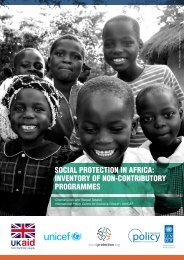https://goo.gl/sZ7V7x
293g79C
293g79C
You also want an ePaper? Increase the reach of your titles
YUMPU automatically turns print PDFs into web optimized ePapers that Google loves.
TANZANIA<br />
Community-Based Conditional Cash Transfer<br />
Programme<br />
Community-Based Conditional Cash Transfer<br />
Country<br />
Tanzania<br />
Geographic area<br />
Sub-Saharan Africa<br />
Previous programme name (if any)<br />
Start date 2009 1<br />
Programme objectives<br />
To test how a conditional cash transfer (CCT) programme could employ<br />
a community-driven development (CDD) approach, and investigate which<br />
systems achieve better results for highly vulnerable populations. 2<br />
Programme type<br />
Conditional cash transfer<br />
Programme components This programme is part of the larger Tanzania Social Action Fund (TASAF). 1<br />
Conditionalities (if any)<br />
To ensure that children are properly educated and that children and<br />
elderly people are healthy: children aged 0–5 had to visit a health clinic<br />
six times per year and those aged 7–15 needed to be enrolled in school<br />
with attendance rates of at least 80 per cent; elderly people had to visit a<br />
health clinic once per year. 2,3<br />
Targeting methods Categorical and community-based targeting. 3<br />
Target areas<br />
TASAF covers villages in the districts of Bagamoyo, Chamwino and<br />
Kibaha, which were the poorest and most vulnerable districts, selected<br />
by ranking the following indicators: poverty level, food insecurity, primary<br />
school gross enrolment ratio, access to safe water, access to health<br />
facilities, AIDS case rates and road accessibility. 1<br />
Target groups<br />
Children and the vulnerable elderly people.<br />
Eligibility criteria<br />
Eligible households had an orphan and/or vulnerable child or an<br />
elderly person (60 years or older). The selection criteria were based on<br />
household characteristics of very poor people, as determined by the local<br />
communities. Vulnerable children were those who were abandoned, or<br />
were chronically sick, or were orphans (one or both parents deceased),<br />
or who had one or two chronically sick parents. Vulnerable elderly people<br />
were those with no caregivers, or who were sick or very poor. Priority<br />
was given to the following categories: first to child-headed households;<br />
second to households headed by an elderly person; and third to<br />
households composed solely of elderly persons. 1,2<br />
Eligibility reassessment (if any)<br />
Type of benefits<br />
Cash<br />
Amount of benefits<br />
The amount of benefits varied according to the number of elderly<br />
people and vulnerable children in each household, from a minimum<br />
transfer of USD12 to a maximum transfer of USD36. A transfer of<br />
USD6 was granted for each child and USD12 for each elderly person,<br />
leading to an average payment of USD14.50 per household. 1,3<br />
Payment/delivery frequency<br />
Bi-monthly<br />
Benefit delivery mechanism<br />
Community management committees were responsible<br />
for making payments to the beneficiary households. 2<br />
Benefit recipients<br />
Usually the mother of the children in the<br />
household—if present—was the recipient. 2<br />
Minimum and maximum<br />
duration of benefits (if any)<br />
Coverage 5,000 households or 13,000 beneficiaries (2013) 1<br />
Programme expenditure By 2011, TZS900,872,500 had been disbursed for this pilot. 4<br />
140 | Social Protection in Africa: inventory of non-contributory programmes



